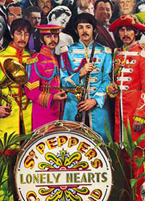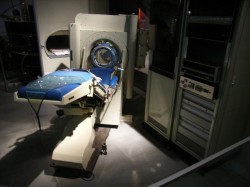The Girl With Kaleidoscope Eyes
August 20, 2009

It’s widely known that Lucy got her name from a Beatles song, Lucy in the Sky with Diamonds. It’s the song that paleoanthropologist Donald Johanson and his collaborators were listening to around the campfire in a remote Ethiopian field camp the night of the fossil’s discovery. Its upbeat and surreal vibe must have matched the mood of the discoverers. Less well known is the way in which the song also helped make it possible to CT scan Lucy 34 years later.
The Beatles recorded their studio albums for Paralophone, a record label owned by EMI (Electric & Musical Industries Ltd.). Fans gobbled up millions of copies of their records. EMI, a British corporation founded in 1931, in addition to producing records, also conducted basic scientific research and developed electronic devices including audio recording equipment, radar instruments, guided missiles, computers, television cameras, and broadcast equipment. Sir Godfrey Hounsfield, an engineer working at EMI’s Central Research Laboratory near London, invented the first commercially viable CT scanner.
In 1971, a patient suspected of having a brain cyst of unknown location became the first medical patient to be scanned with the new device. Miraculously, the CT image clearly indicated the cyst’s location. (In earlier trials, Hounsfield practiced on the head of a cow that a colleague brought him from a slaughterhouse.)

The CT scanner has gone on to become an indispensible tool in hospitals and clinics around the world as a way to safely look inside the body of a living person without the risks and suffering associated with surgery. Hounsfield shared the 1979 Nobel Prize in Medicine for the invention.
However indirectly, the astronomical profits EMI gleaned from the Fab Four’s record-setting career helped create the technology that would one day make possible entirely new discoveries about the world’s most famous fossil.
Thank you John, Paul, George and Ringo!
by Marc Airhart
For more information about the Jackson School contact J.B. Bird at jbird@jsg.utexas.edu, 512-232-9623.
